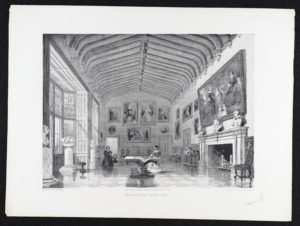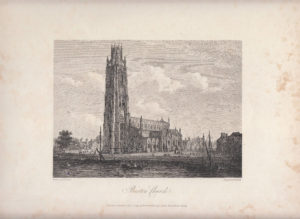Since its formation in 1948, successive members of the Centre for Regional and Local History (CRLH) – formerly the Centre for English Local History – have collected printed images of English buildings and landscapes (and some from Wales). Most of the material dates from the eighteenth and nineteenth centuries, but there are a few items from the seventeenth and the twentieth centuries. By 2019, the collection – numbering over 2000 prints – was underutilised and showing the effects of sub-optimal storage and repeated handling. Andrew Hopper (now at the University of Oxford), Angela Muir and Richard Jones of CRLH – together with one of us (JB) – launched a project to digitise the collection to ensure its preservation and extend access and usage.
Most prints carried reference numbers, but as there was no catalogue, missing prints, and gaps in the numbering, a new system was needed. The original pre-1974 county organisation was retained. Each county was given a code, generally the first five letters of the name. Within each county, the prints were sorted into numerical order using the past reference number, where available, and then renumbered from 001. The number of prints for a county ranged from as few as three to over 400. For each print, JB recorded the old reference number, new reference number, county, place, title, artist, engraver, publisher, place and date of publication, and date of original artwork, amongst other details. Alongside the cataloguing, many of the prints were scanned to TIFF files. Notes accompanied about 30% of the prints and these were scanned also. Next, AS scanned the remaining prints to the same standard, built a detailed searchable catalogue according to the Dublin Core metadata standard and uploaded this and the images to University of Leicester Special Collections Online. Published as ‘Views of England and Wales’, it now sits alongside other topographical image collections including the Fairclough Topographical Collection and Ghost Signs of Leicestershire.[1] The images have been released under a Creative Commons Attribution-Non-Commercial license (CC BY-NC 4.0) which allows them to be re-used for non-commercial purposes, if CRLH is credited. AS built an accompanying online exhibition providing a more detailed introduction to the collection.[2]

Credit: Centre for Regional and Local History, University of Leicester. Licensed under: CC BY-NC 4.0.
The collection includes prints from many midland counties, such as the interior of the Great Hall at Charlecote from 1845 (Figure 1) or Boston Church, Lincolnshire from 1799 (Figure 2). Some counties have few prints (Bedfordshire: 1, Derbyshire: 4), while others are better represented (Gloucestershire: 469, Lincolnshire: 53), possibly reflecting the interests of the collectors rather than those of the print makers. The diverse nature of the prints means they will interest many historians. Landscape and building historians will find illustrations of buildings and landscapes as they were up to 250 years ago, including buildings since demolished or ruined. Around 60% of the images include people, which will provide material for fashion historians and, as many show people at work, social history researchers.

Credit: Centre for Regional and Local History, University of Leicester. Licensed under: CC BY-NC 4.0
We hope that people will use the collection in new and creative ways, such as utilising IIIF (International Image Interoperability Framework), a way of sharing and viewing digitised images which is being adopted by libraries and museums. Anyone can import IIIF-enabled images into user-friendly viewers like Mirador, or a workspace like Recogito. As well as providing tools for deep zoom, comparison, and annotation, they allow you to combine images from different collections in one space. For example, you could take images of Boston Church from our collection, the Yale Centre for British Art and the University of St Andrews and view them together in Mirador, without having to download any files or install any software. This has the potential to make research with images more efficient and innovative in the future. We are interested in hearing from anyone with ideas for projects that make use of Views of England and Wales.
Juliet Bailey, Alister Sutherland (Centre for Regional and Local History, School of History, Politics, and International Relations) and William Farrell (University Library), University of Leicester, University Road, Leicester, LE1 7RH.
[1]University of Leicester Special Collections Online, ‘Views of England and Wales,’ <https://specialcollections.le.ac.uk/digital/collection/p16445coll16> [accessed: 13 May, 2023].
[2] Alister Sutherland, ‘An Introduction to Views of England and Wales,’ <https://elhleics.omeka.net/exhibits/show/an-introduction-to-views-of-en> (2023).
